6 Best Desert Boots for Men in 2025, No Matter How You Wear Them
Conventional wisdom states that boots belong in the cooler months, but there’s one model that breaks the mold: the desert boot.
Shorter than a boot but taller than a shoe, desert boots got their start in Africa (more on that later) and stand out for typically having a breathable suede upper and a soft crepe rubber sole. They aren’t boots that scream rugged and all terrain. They suggest lightness, relaxed vibes, and breezy comfort.
In other words: you can still wear boots in summer. These are the best.
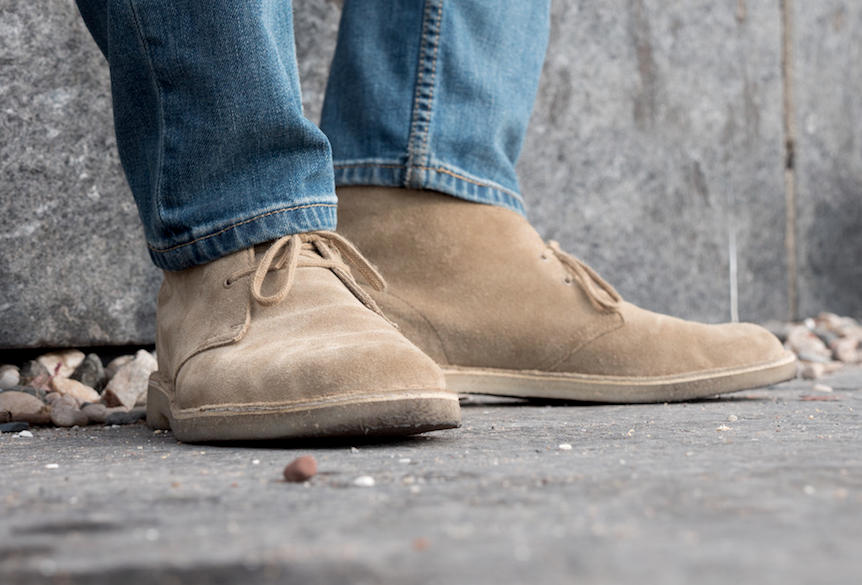
The Most Famous Desert Boot: Clarks Desert Boot ($160)
No article about desert boots is complete without talking about the desert boot from Clarks. This model has over eighty years of history and has cemented its place in footwear culture (of course that’s a thing), and most of its flaws are also its strengths. Here’s what I mean.
The world's best known desert boot is still well priced, with a lightweight and breathable build that makes it great for summer or for guys who prefer boots with a sneaker-like feel.

Clarks Desert Boot Highlights
Serious boot aficionados turn their nose up at the Clarks Desert Boot (CDB) for a few reasons: it’s floppy and unstructured, the suede’s pretty thin, it’s very light and insubstantial feeling, the spongy sole doesn’t offer much stability or surefootedness, and it’s hard to resole. (Cobblers argue about how easily it can be resoled, but what’s definite is that you’re less likely to find one who’ll take on the job.)
But the thing is, all those things make this a pretty good desert boot. That the materials are light, airy, and insubstantial mean CDBs breathe well and feel like walking on a cloud. And after all: it’s made with suede from Britain’s word famous C.F. Stead tannery, the stitchdown construction is more sophisticated than any sneaker, and it’s fairly priced.
I’d complain if these were twice the price, but as is? It deserves its reputation.
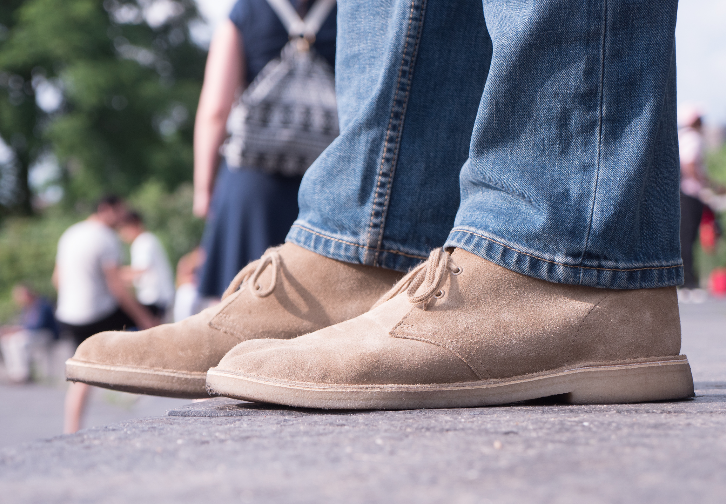
Who Should Buy Clarks Desert Boots
- Guys who want the original; this boot is consistently recommended by style enthusiasts as one your wardrobe just can’t do without.
- Value minded shoppers: this is a good price.
- Men who are used to sneakers and prefer their lightness and flexibility.
- People who want boots that breathe well in the heat.
The world's best known desert boot is still well priced, with a lightweight and breathable build that makes it great for summer or for guys who prefer boots with a sneaker-like feel.
Who Shouldn’t Buy Clarks Desert Boots
- People who prefer a smarter desert boot: the upper is so thin and floppy that you can sometimes see your toes.
- Guys who get sore feet: this isn’t medical advice, but the sole is very soft and squishy even for crepe rubber. There’s no stability here, which many value in their footwear.
It’s not perfect, but without the classic CDB, the rest on the list may have never been made.
Best Value Desert Boot: Thursday Boot Company Scout ($160)
The CDB is incredibly iconic, but there are good arguments for putting the Scout ahead of it on this list. It’s the same price, the same look, and it’s better made. There’s no arguing that it’s not better value for money, even if it’s not exactly what you want. Here’s why.
This Goodyear welted chukka boot is inexpensive, resoleable, and available in dressy, casual, and outdoorsy builds.
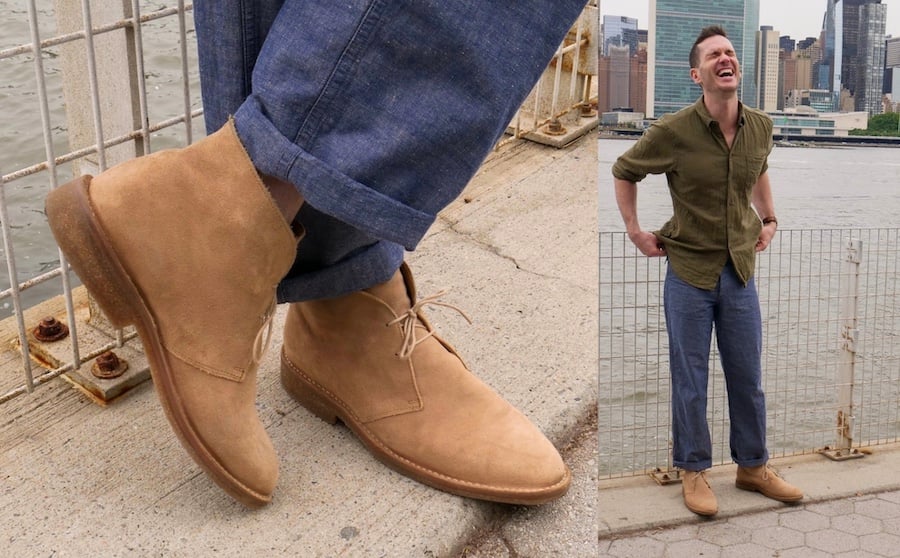
Thursday Boot Company Scout Highlights
Chukkas are often worn business casual and there are plenty of Scouts (other Scouts, in other leathers) that dress up much more easily thanks to their more durable soles and dressier leathers.
And there are more outdoorsy Scouts that are tougher than Clarks: look for the “Rugged and Resilient” ones that have thick wedge soles and oil tanned leather.
There’s one Scout, though, that’s clearly meant to be a leveled up CDB, and it’s this one in “Dune Snuff Suede.” It’s superior because it’s easier to resole, more water resistant, less slippery on wet surfaces, it’s fully leather lined, has a much tougher crepe on the sole, and has more layers underfoot (including cork and veg tan leather) that will conform to your foot’s shape with wear like a higher quality boot.

Who Should Buy Thursday Boot Company’s Scout
- Guys who want a longlasting desert boot: this is easier to resole, plus the sole takes longer to wear down in the first place.
- People who want a dressier desert boot — or a more outdoorsy one.
- Anyone who likes a good value buy: this is the same price as Clarks but it’s a level up in every way. Except…
This Goodyear welted chukka boot is inexpensive, resoleable, and available in dressy, casual, and outdoorsy builds.
Who Shouldn’t Buy Thursday Boot Company’s Scout
- People who like a floppy, lightweight, insubstantial desert boot might not prefer the tougher and more structured Scout.
- Folks who prize breathability above all else: the leather lining and extra layers underfoot are more comfortable in most ways, but it doesn’t breathe quite as well.
The Scout is unmatched in value because of the stitchdown build, leather lining, and more typical boot construction.
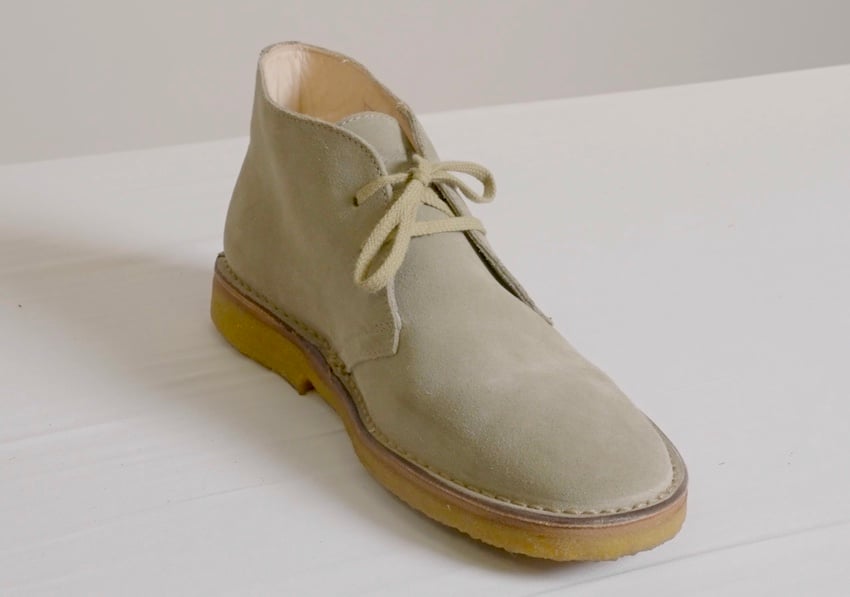
Italian Made: Astorflex Brownflex ($225)
This might be the closest on this list to a classic, casual desert boot that’s higher quality than you might be used to.
Made in a small Italian workshop in its 6th generation of family ownership, this brand is well known for their love of crepe soles, suede uppers, and balance of comfort and durability.
Astorflex Brownflex Highlights
Made in northern Italy by a small brand in its sixth generation of family ownership, the Brownflex is the rare desert boot that costs under $300 but is still highly respected by the most discerning of boot snobs. (They’re sold at New York’s Leffot, which is a serious tick of approval in the industry — but if you’re shopping online, get them at Huckberry.)
This brand is known for their love of suede, crepe soles, and chukkas, so the Brownflex was a natural fit for this list. It’s fully leather lined and has just the right kind of construction and amount of leather underfoot that it’s sturdier than budget desert boots without seriously hampering the breathability or comfort.
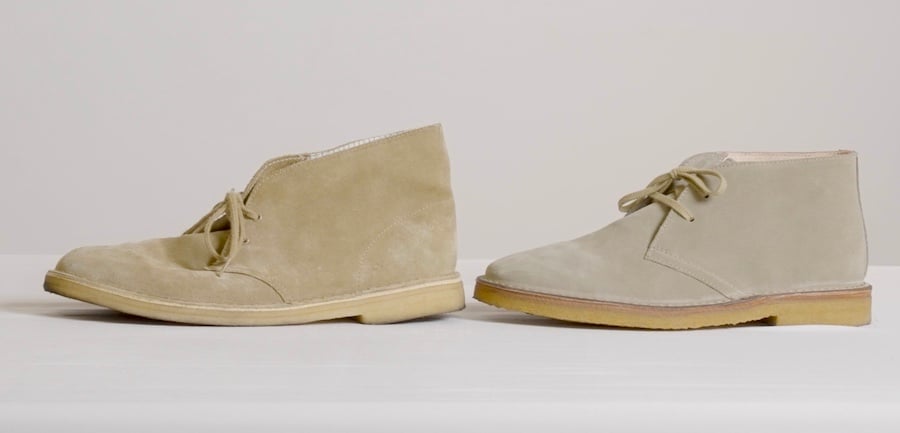
Who Should Buy Astorflex Brownflex
- People who want a desert boot that’s better made than most, but still works best when worn casually.
- Guys who like the idea of desert boots made by a small, family-owned brand.
- Folks who want a desert boot that deftly balances lightness and stability.
Made in a small Italian workshop in its 6th generation of family ownership, this brand is well known for their love of crepe soles, suede uppers, and balance of comfort and durability.
Who Shouldn’t Buy Astorflex Brownflex
- People looking for a more refined desert boot that can be easily dressed up.
- Guys who don’t want to pay over $200.
The Astorflex Brownflex might be the best Clarks alternative because it’s the precise same level of casual, but it’s better made.

Best USA Made Desert Boot: Red Wing Weekender Chukka ($270)
This casual chukka used to only be sold in tough work boot leathers, but in 2025 the lineup expanded to include a range of fuzzy roughouts, making them the best American-made desert boot.
One of the Red Wing's most lightweight and flexible boots, this chukka combined work boot leather with thin cushy soles to give the best of both worlds.
Red Wing Weekender Chukka Highlights
Most of Red Wing Heritage’s boots are made with beefy construction designed to last all manner of abuse, but the Weekender line is different: billed as leisure boots as opposed to work boots, the Weekender Chukka is incredibly lightweight and flexible thanks to the stitchdown construction and extra thin rubber sole.
Lately, Red Wing Heritage has been putting more work into positioning their boots as casual wear for cool kids, which means they’ve come out with some new leathers that you might not know about. The Weekender Chukka is currently sold in roughout leathers that, while thicker than suede, make for perfectly appropriate desert boots: a chocolate brown, a white sand, and a light blue that’s exclusive to Huckberry.
It’s a very cool option especially if you like made in USA products or if you’re looking for a Red Wing boot that’s under $300.
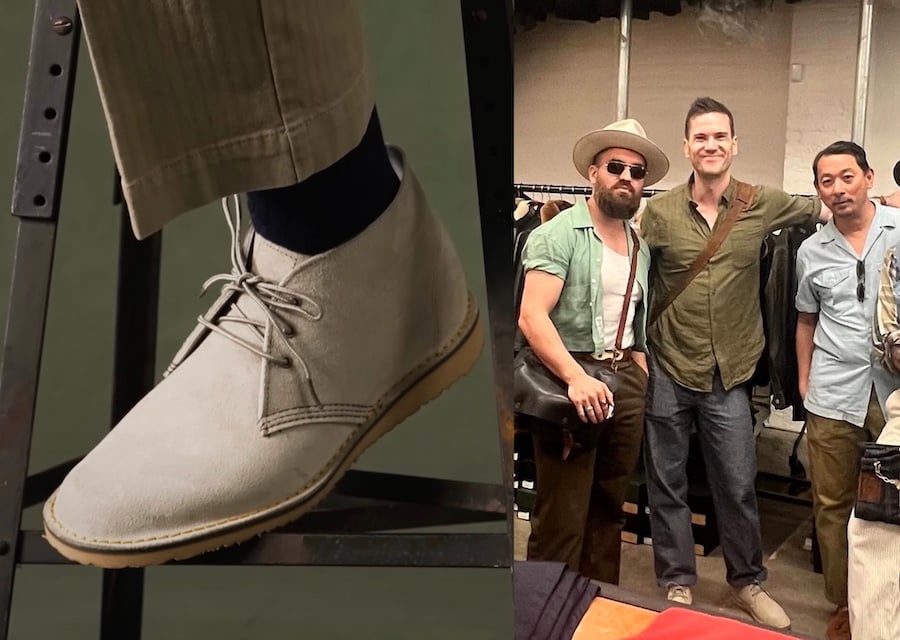
Who Should Buy Red Wing’s Weekender Chukka
- People who value American made boots.
- Anyone who likes the sound of a Red Wing boot that’s light, flexible, and easy to break in.
- Folks who want a chukka with work boot leather with more cushy construction.
One of the Red Wing's most lightweight and flexible boots, this chukka combined work boot leather with thin cushy soles to give the best of both worlds.
Who Shouldn’t Buy Red Wing’s Weekender Chukka
- Guys who can’t spend $270 on boots.
- People who prefer the stability of a Goodyear welted boot; these are very squishy underfoot.
This is a solid entry into the desert boot style, especially if “Made In USA” matters to you! And I love that they offer a range of nappy roughout leathers for guys who want a desert boot and they sell one with a work boot leather if you prefer that look.

Best Desert Boot for Hiking: Jim Green Vellie ($135)
If you’re someone who looks at a desert boot and thinks, “I like the idea, but I’d prefer a boot that can take a beating,” then the Vellie is for you.
Drawing on the region's tradition of veldstchoen boots, South Africa's Jim Green has made a desert boot that's sturdy, resoleable, and ready for the outdoors.
Jim Greene Vellie Highlights
Desert boots have a lot of history in Africa: they were worn by soldiers in World War 2’s Western Desert Campaign and by British officers in northeast Africa, but they say that South Africa started it all with their veldtschoen boots that later inspired desert boots. Veldtschoen is a type of stitchdown-like construction that is hard to say, and eventually they just got called vellies.
Jim Green’s Vellies stand out for being super wide and round at the toe and for being made with tough leathers, harder crepe soles, and a steel shank to improve stability. All this makes them easier than most to take out hiking or bushwalking — though they’re very casual looking as a result.

Who Should Buy Jim Green Vellies
- For those who want boots that can be worn with shorts, these might be your best pick.
- Guys who want a roomy desert boot that lets your toes splay.
- Anyone who wants a desert boot that’s made for handling tough outdoor wear.
- Those on a budget: at just $135, this is great value for money.
Drawing on the region's tradition of veldstchoen boots, South Africa's Jim Green has made a desert boot that's sturdy, resoleable, and ready for the outdoors.
Who Shouldn’t Buy Jim Green Vellies
- People who want a versatile desert boot; this is the most casual on this list.
They don’t call it the official South African shoe for nothing: this is an awesome choice for those who want a desert boot that looks like it actually belongs outdoors.

Best High End Desert Boot: Crockett & Jones ($680 – $945)
But since our theme is ‘nicer desert boots,’ I thought we should have at least one luxury pick where price isn’t a concern — even though I want you to be very impressed that so far, every pick has been under $300.
There are plenty of high quality desert boots, but I wanted to make sure this one was from a company whose chukka is an important part of their brand.
Then I remembered that outside of Clark’s, I think pop culture’s most influential desert boots come from Crockett & Jones.
Known for quality British craftsmanship (and for being worn by James Bond), this brand's chukkas are so popular they have a dozen different, high end models.
Crockett & Jones Chukka Highlights
Completely made in Northampton, England, this kind of boot is such an integral part of Crockett & Jones that at the time of writing, they sell about a dozen different versions.
Their bestseller is the Molton, worn by James Bond in No Time to Die, but that’s more of a tough, all-weather chukka. For a desert boot, I’d recommend two models.

The one just called Chukka might be the best option because the upper’s unlined suede and the sole is leather, which actually breathes better than crepe — so while it’s a very narrow boot, it might be the most ideal pick for a desert boot on this list. It’s meant to lean dressy, so again, it’s awfully slim. Unlined suede will stretch, but still.
For guys after a more casual desert boot, they’ve got the Chukka 4, which has a roomier fit, though it has a rubber sole so it’s not quite as summer-perfect. Other good options are the Chepstow (if it’s still sold in the Sand color, which is the closest in appearance to Clarks) or the Kew, which is the highest end option at $945.
Who Should Buy Crockett & Jones Chukka
- People who like the idea of handmade chukkas in England’s traditional shoemaking headquarters of Northampton. (See also: Tricker’s, Edward Green, Crown, and others)
- Guys who prefer Goodyear welted footwear over the stitchdown construction on most of this list’s offerings; it’s a lot easier to find a cobbler to resole these.
- Anyone who likes the idea of wearing James Bond’s brand; just about everything Daniel Craig wore on his feet in his movies was from this company.

Who Shouldn’t Buy Crockett & Jones Chukka
- Guys on a budget; the cheapest option is $680 right now.
- People who are after cushy and soft crepe soles; most of them aren’t on crepe an those that are have a pretty tough and stable version of the material.
Almost every nice footwear brand sells a desert boot — John Lofgren’s is another that leads the pack, and Jadd’s is pretty iconic. But you can’t go past Crockett & Jones, especially since they’re made in the same country where Clarks is headquartered.

Desert Boots vs Chukka Boots
- A chukka is a short boot with just two or three pairs of eyelets
- Desert boots are usually chukkas made with suede uppers and/or a crepe sole
All desert boots are chukkas, but not all chukkas are desert boots.
A chukka is a short boot with few eyelets: in most instances, a chukka barely covers the ankles and has two or three pairs of eyelets to secure it onto the foot.
a desert boot is a chukka designed for casual wear in warm weather.
No one is really controlling these definitions, but desert boots are generally understood as chukkas with crepe rubber soles. That’s the most indisputable marker of a desert boot, but folks tend to agree that they should have suede uppers as well.

Lastly, a lot of chukkas are made with Goodyear welt construction, but desert boots tend to be made with stitchdown construction. Stitchdown can be used to make monstrously beefy work boots, but it can also be used to make something lighter and less “overbuilt” than a Goodyear welt, which is how desert boots are usually made. You don’t need quite as much material underfoot with a stitchdown boot.
In other words, a desert boot is a chukka designed for casual wear in warm weather. Shoemakers have told me that leather soles actually breathe better than crepe, but crepe soles are soft and perhaps more importantly, they lend a more relaxed, casual look.
Desert Boots and Crepe Soles
Let’s talk a little more about the biggest differentiator. The crepe sole is really what most people associate with desert boots.
Crepe usually comes from Mother Nature herself. In many parts of South America, rubber trees are tapped the way maple trees are tapped for their syrup. Instead of syrup, rubber trees produce a liquid that’ll eventually turn to your crepe soles.
This is different to harder rubber like Dainite, which is made of vulcanized rubber, a process that makes it much tougher.
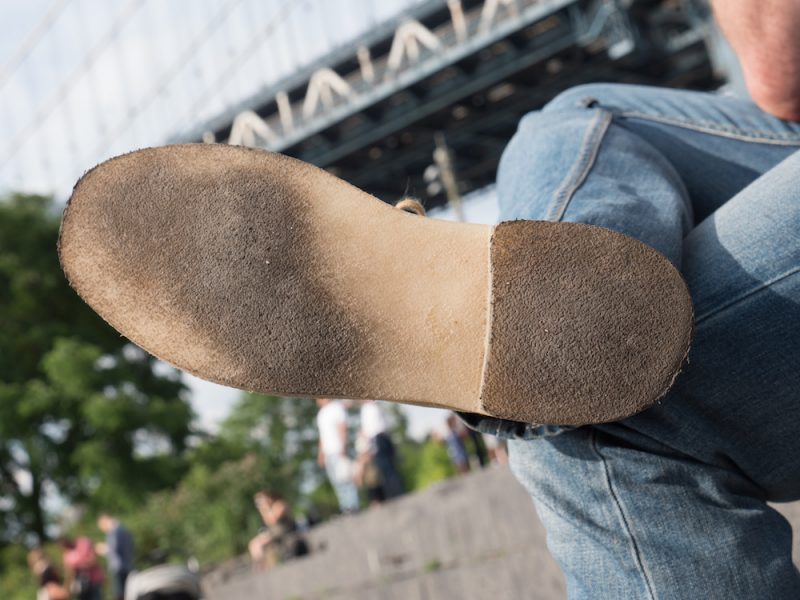
Not all crepe rubber soles are the same: I’ve worn everything on this list, and they all have different levels of softness. Clarks is the softest, which also makes it the least durable. If you rap on Clarks crepe with your knuckle it doesn’t make a sound, while the rest of these soles will produce that hard “knock.”
But even the harder crepe soles are generally softer underfoot than other rubber soles. One thing to note is that in my experience, crepe soles pick up dirt really quickly: from your very first day of wear, you’ll start to see the shape of your foot appear on the bottom of the sole.
[Related: The Ultimate Guide to Crepe Soles]

Desert Boots and the Military
The origins of the desert boot stretch back to South African veldstchoen boots. But it’s most commonly associated with soliders further north in Africa, who wore them in World War 2. They’re best known for being worn in the Western Desert Campaign, which took place in Egypt and Libya after Italy invaded Egypt in 1940.
The desert boot began its move to civilian feet with Nathan Clark, the great grandson of Clarks’ founder. Nathan noticed many soldiers wearing a form of desert boot while stationed in Burma during World War 2, and he wanted to make this cost effective design for potential customers back home in England. Suede and crepe were considered fairly “low class” back then and he didn’t find much success in England, but the design became very popular when he decided to instead sell desert boots in the United States in the late 1940s.

How To (and Not to) Style Desert Boots
Desert boots are glorious in their simplicity: typically constructed with just three pieces of suede, two or three pairs of eyelets, and little to no structure. And while suede can be dressed up to business casual, the addition of a crepe sole keeps desert boots pretty firmly casual.

Guys who are very interested in menswear and have a rock solid understanding of how to bend traditional rules can find creative ways to wear just about anything. Our friend Peter from Peter’s Prism, for example, has been known to wear military field jackets with a tie.

But most guys don’t want to think so hard about what to wear, so I’d recommend most guys wear desert boots casually. Jeans, chinos, and fatigues can all be excellent warm weather trousers. Shirts like chambray, denim, oxford cloth, camp collars, polos, and t-shirts all work well.
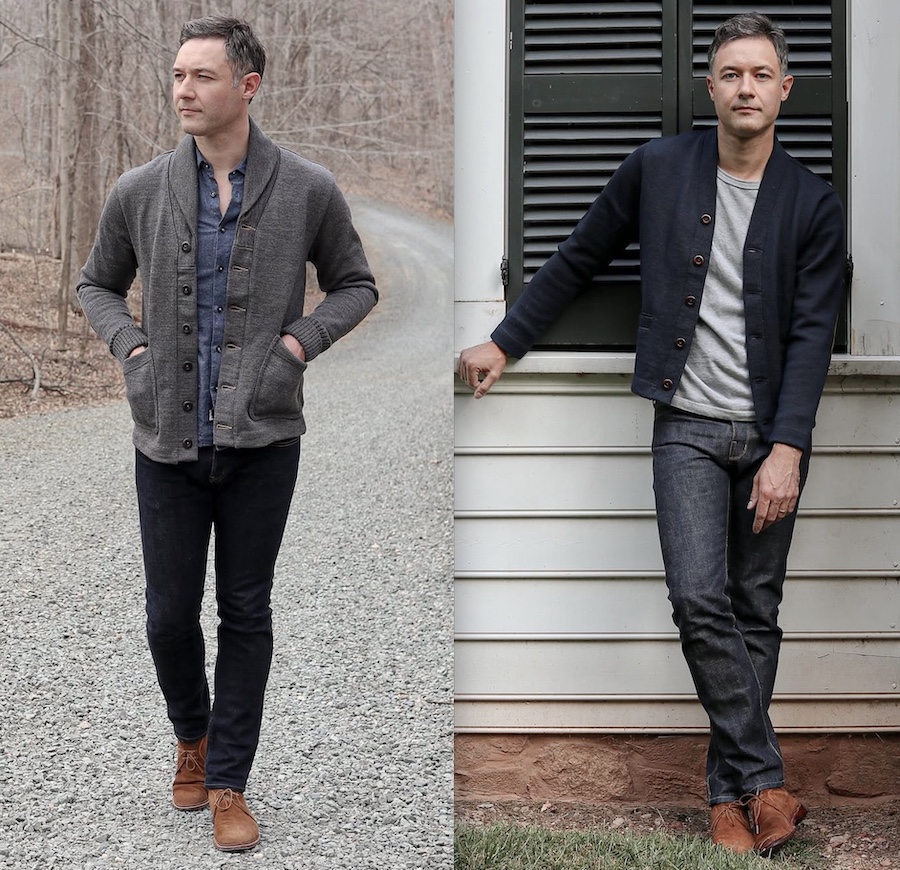
They’re known as summer boots and they work great with summer fabrics, but that doesn’t mean they can’t work in cooler weather. Our writer Mike here enjoys wearing his suede chukkas from Alden with various cardigans and chore coats.

While I would advise against pairing them with a tie, desert boots can look great with a sports jacket and button down.

A great thing about the popularity of desert boots is that you aren’t confined to classic menswear or workwear. With some kinds of footwear, like derbies, you might feel compelled to wear more vintage or dressy clothing and look: I love doing that. But as Albert shows above, desert boots work great with a modern polo shirt and jeans. It’s a big benefit of this kind of boot being so widespread and of it being considered a casual staple.
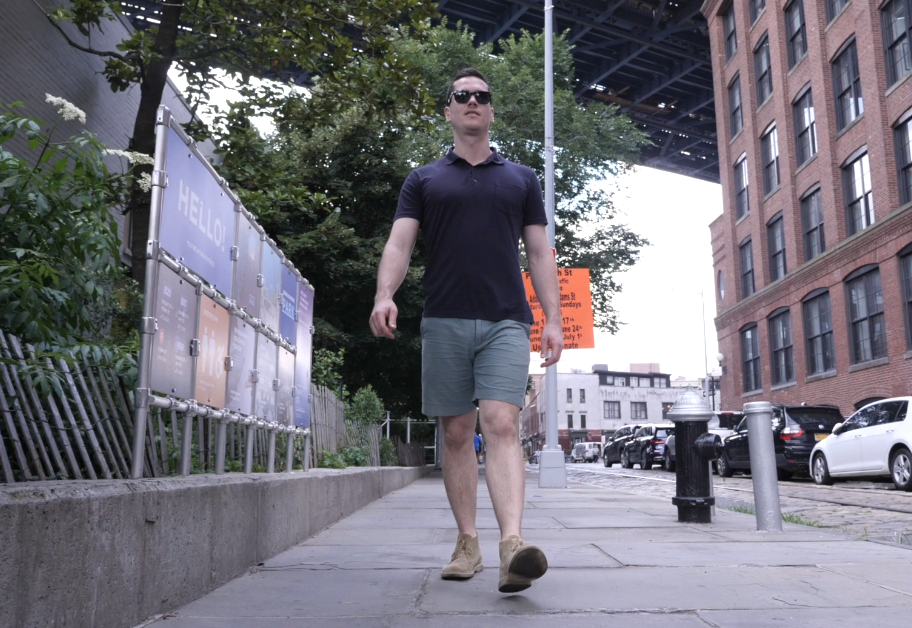
Should I Wear my Desert Boots with Shorts?
You probably shouldn’t — I copped an insane amount of flak flack when I tried this out in my Clarks Desert Boot review a few years back.

I hear that vellies, chukkas like Jim Green’s, are often worn with shorts in South Africa and nobody cares.
Here in the States, the key is to not wear desert boots that are too sleek or shorts that are too baggy. And you might want to keep off the internet if you’re trying this look out. The commenters can be merciless.
Wrapping Up
Alright! I’m pretty happy with this list and I spent a ton of time working on it. Maybe you’re after a desert boot that’s dressy, more casual, more outdoorsy, more luxury, or more American, there’s a solid entry for you here. Let me know in the comments which one you liked the best!




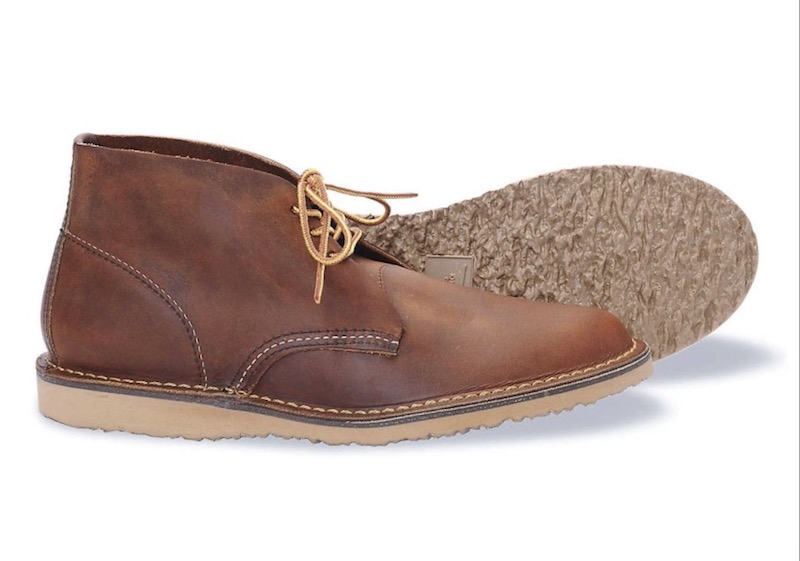




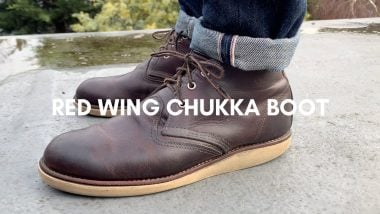
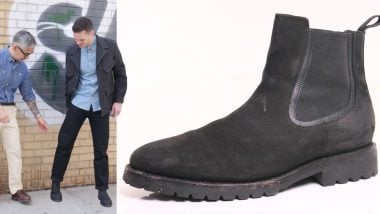

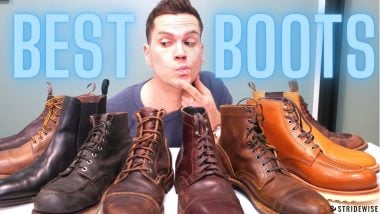

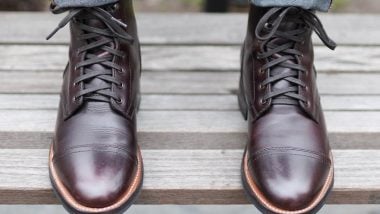
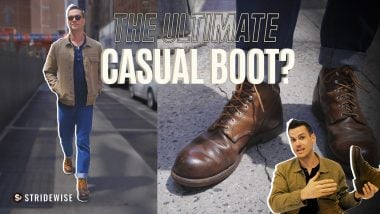
Fantastic round-up – I appreciate this list!
So glad you found it, AJ!